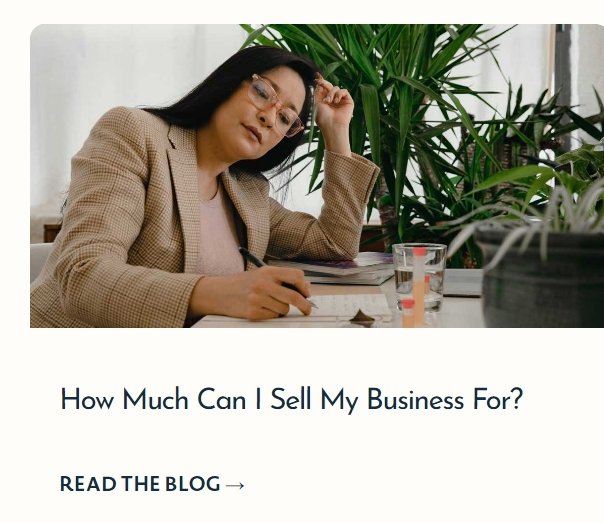Report: The Gender Gap in Business Exits [2024 Insights]
Imagine building a successful business as a female founder, only to sell it for 30% less than a male counterpart would. If that doesn’t sit right with you, you’re not alone. The Exit Gap, the gender disparity in business exits, is a reality that many women entrepreneurs face today.
The exit gap is not as widely recognized or studied as other gender gaps, such as the pay gap, the funding gap and the wealth gap. This lack of awareness can make it harder for female business owners to recognize and address the challenges they face in exiting their businesses. So understanding this gap is crucial because it directly impacts the financial success and legacy you can create from your hard work.
Most entrepreneurs fail to realize this exit gap exists until it’s too late—often leaving life-changing money on the table.
The Data on Gender Disparities in Business Exits
Female-Owned Business Exits Are Shockingly Low
According to the first research on the exit gap, done by London-based accounting firm Buzzacott over a 10-year period, less than 1% of businesses that sold a majority stake were female-founded. In the U.S., this figure was 1.37%, and in Europe and the rest of the world, it was just 0.35%. These statistic highlight the significant underrepresentation of women in business exits, especially compared to male counterparts.
Lower Transaction Values for Female-Owned Businesses
That same study found that male-founded businesses in the Technology, Media, and Telecommunications (TMT) sectors were valued 1.5 times higher on average compared to their female-founded counterparts. Additionally, in the consumer sector, male-owned businesses were valued 18% higher than female-owned businesses.
“Even if a female-founded business is sold, it is likely to fetch a lower price compared to a male-founded business. For every $1 million a female founder receives, a male founder might receive $1.5 million for a similar business, reflecting a significant disparity in exit outcomes.” Lien De Pau, founder of The Big Exit.
Valuation Biases
The Buzzacott report also underscores the systemic undervaluation of female-founded businesses. This is a significant factor contributing to the exit gap, where women receive less financial return when selling their businesses compared to men.
“The undervaluation of female-founded businesses is a significant issue. Despite identical businesses being run by a man and a woman, the male-led business is likely to be valued and sold for more. This discrepancy highlights the systemic biases that persist in the business valuation and exit processes.” Lien mentions on the Women On A Rise podcast.
Steps To Overcome The Exit Gap
Independent Valuations
We cannot emphasize enough the importance of obtaining an independent valuation to avoid the biases that can occur when brokers (or other invested parties) over- or undervalue a business based on gender.
Obtaining an independent business valuation and understanding the strengths and weaknesses of the business can help female entrepreneurs negotiate better deals and prepare their businesses for sale more effectively.
We’ve created a guide with independent advice on
how much you can sell your business for:
Seeking Female Investors and Seller/Buyer Networks
Here at The Big Exit we suggest seeking out female-led private equity (PE) firms and connecting with communities of women who have successfully exited their businesses. This can help female entrepreneurs navigate the biases and challenges in the exit process.
Taking Ownership of the Exit Process
Every expert we spoke to about the exit gap emphasizes the importance of women educating themselves about the exit process.
This education should begin early, well before you plan to sell, to ensure you are fully prepared when the time comes. Knowing how businesses are valued, and what factors drive valuation, can help you better prepare for negotiations and avoid being undervalued.
Awareness and Preparing for Your Big Exit
Carrie Kerpen, CEO of The Whisper Group, underscores the importance of awareness:
“When I sold my company for an eight-figure sum, I learned that women business owners have different experiences when it comes to exiting their businesses than men. People react when I mention that. Men hate it. Some women hate it, too. We want to believe that we all have the exact same opportunities, and that there are no differences in what we are capable of. And while women certainly are capable, our journey is unquestionably more difficult.”
For female entrepreneurs, the key takeaway is to prepare early and with strategy. Begin with an independent valuation to understand your business's worth without bias.
Next, focus on building strong networks, particularly with experts, like women owners who’ve exited their business, female-led private equity firms and communities of female business owners looking to exit.
Resources for Deeper Understanding
To explore these trends further, visit the Buzzacott Exit Gap Study or The Exit Gap Report by Carrie Kerpen.
For practical tips on getting exit-ready and sell your business for maximum value, consider reading our weekly blog from front to back.
Listen to “The Surprising Truth About Female Business Exits” episode on the Women On The Rise podcast, where our founder Lien De Pau is being interviewed on this matter.


